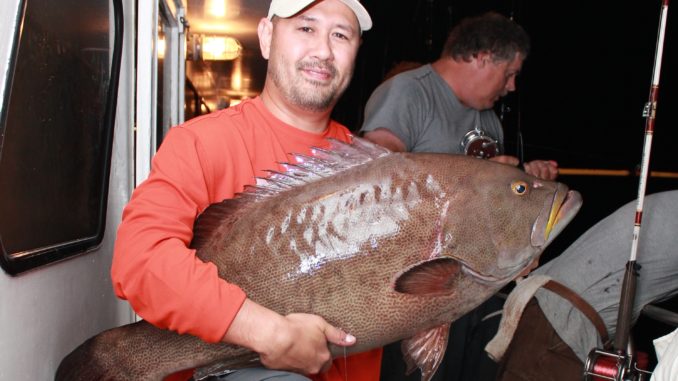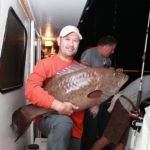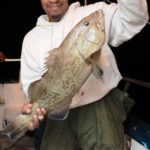
Make a plan and stick to it to load your boat with grouper and other bottomfish
“Okay gentlemen, drop it down, drop it down, drop it down. All the way to the bottom. If you’re not on the bottom, you can’t catch these fish.”
It was around midnight on evening last fall year when Capt. Dave Tilley gave instructions to the anglers on a first-of-its-kind trip aboard his Morehead City-based headboat, the Continental Shelf. He had just made sure the boat’s anchor held strong, and within minutes of his command, fishermen were hooked into amberjack, a variety of grouper and snapper, a scene that would be repeated several times over the next two days on the boat’s first-ever 48-hour offshore bottom-fishing excursion.
The idea for an extended headboattrip was Tilley’s; he wanted to see how good the fishing could be if he could fish places too far away to get back to the dock in a single day. He explained to his fishing party that fall is a great time to stay out a long time because, barring a tropical storm, the weather is relatively stable and predictable, and it gives fishermen a chance to catch two or three days’ worth of limits. Leaving at 6 p.m. on Wednesday and returning at 6 p.m. on Friday would allow anglers to catch and keep limits on Wednesday, Thursday and Friday, if the fishermen would just be flexible.
“The feeding cycle, the current, the wind — it can all change quickly, and sometimes you have to bypass a spot you’ve had success in or move from a location that is currently giving up fish. That is one advantage of running these 48-hour trips. We have time to be selective in where we fish.” Tilley told the his fishermen. “My goal is for one of you to catch a record grouper on this trip.”
A matter of a few hours after Tilley’s instructions, his goal of a record grouper was reached, as Knightdale’s Toby Grantham landed a state-record scamp grouper that weighed in at 27 pounds, six ounces..
While having time to get further out to deeper water and spend more time fishing than cruising, Tilley said that isn’t the biggest benefit to running 48-hour trips, whether on a headboat or a smaller private vessel.
“This time of year, grouper can be caught fairly close to shore as well as out deep. The best part about being out here 48 straight hours is that you can’t miss the feeding cycle,” Tilley said. “No matter the moon phase, no matter the current, no matter the tide cycle, none of these fish are going to go 48 hours without feeding.”
But anglers can’t simply anchor down and soak bait for two days and expect to get the most out of their trip. Tilley said paying attention to your electronics plays another big part in getting on the grouper.
“When I’m looking for grouper, I want to see a ledge with a drop off that leads to another ledge,” he said, “and I don’t want to see a big ball of bait hovering over those ledges. If I see a huge cloud of baitfish, that tells me no predators are present. What I want to see on my electronics is fish packed tight to the bottom. These are likely predators lying low, waiting on baitfish to swim by.”
Tilley said the ocean floor is often a reef with large holes for grouper to back into. From there, they ambush baitfish, then retreat quickly back into their holes. This is a problem for anglers, who will often hook a grouper, but then find themselves in a losing battle as the grouper uses its cover to thwart the angler’s efforts.
“The fish simply get stuck, and your line might as well be tied directly to the reef when this happens,” Tilley said.
Grouper will eat a variety of baits. Cut baits from fresh fish and squid will catch grouper, but Tilley said fishermen targeting big grouper will increase their chances greatly by using either cigar minnows or large jigs. As far as technique is concerned, when using cut bait, there isn’t much to it outside of keeping your bait in the right place. Whenever he anchored up on a spot, Tilley tells his party whether he is seeing fish right on the bottom or hanging out a few feet or so above the ocean floor. Anglers can then simply keep their bait on the bottom or reel up the required number of times to put their bait where the fish are.
Using big jigs is a different story. Jigs ranging from two ounces up to more than a pound are not uncommon when targeting grouper. In fact, Grantham, who caught the state-record scamp grouper, caught it on a 4-ounce Blue Water Candy jig in 180 feet of water east of Cape Lookout. Grantham also landed a big red grouper on the same jig that barely missed 20 pounds, the minimum for earning a citation from the N.C. Division of Marine Fisheries.
Grantham said jigging isn’t the easiest way to fish, but it’s certainly effective. Rather than drop the lure down and let it soak like natural bait, jigging involves dropping the heavy lure down, then employing a yo-yo action to make the jig dance up, then drop back down, over and over and over. This takes stamina, as working a rod-and-reel combo big enough to handle grouper is tiring and muscle-testing, and that’s before a grouper is even on the line.
When a grouper bites, the angler needs to move the fish away from any cover as quickly as possible. Tilley’s first mate, Joe Dowell said this is where many anglers make their biggest mistake.
“You don’t want to pump and reel like most anglers’ first instinct is. You can do that with a lot of fish out here, but drop that idea when you have one hooked that you just can’t seem to budge,” he said. “Instead, you want to rest the fishing rod on the boat’s rail, then reel, reel, reel.
“Pumping and reeling gives the fish a chance to run each time you lower the rod tip and each time you stop reeling. Keep the rod on the rail and reel, reel, reel,” said Dowell, warning that to do otherwise could allow a grouper to get back to the reef or cover and escape.
When bottom-fishing, plenty of species are present and willing to bite. The 28 anglers aboard the Continental Shelf caught more than 30 species of fish on the 48-hour trip, including several species of grouper and snapper, plus triggerfish, black sea bass and amberjack, among others, all of which were caught while fishing on or directly off the bottom.
Jim Wright of Bedford, Ind., was reeling in a small grouper when a big barracuda snatched it. Wright caught the ’cuda, which Dowell said was probably a state record.
“It weighed 74 pounds on our scales, but since you can’t eat them, I convinced Mr. Wright to throw it back. I regretted that after finding out later the state record is 67 pounds,” Dowell said.
In asking anglers to be flexible, Tilley practices what he preaches, even to the point of trolling for wahoo and stopping along weedlines to give his anglers opportunities to cast plugs at dolphins. At the beginning of this trip, anglers pulled numbers to establish the order of getting a shot at a wahoo. The dolphin bite was slow, with 15-year-old Zac Tilley reeling in the only one that bit. Wahoo were more active, and anglers boated five of the seven that struck while the Continental Shelf was trolling for them.
“It’s another great thing about being out here 48 hours,” Tilly said. “You would never have time to do this on a typical bottom-fishing trip.”
Besides looking for ledges, Tilley said it’s important to have some current, which triggers the feeding instinct of fish. And anchoring is crucial, he said.
“Look at your electronics, get a feel for the wind and current, which are often working against each other. Estimate where dropping anchor will put you on top of the hole you’re wanting to fish, then anchor down. Once the anchor catches, if you aren’t where you want to be, don’t waste time; pull the anchor back up, and try again,” he said.
“The best fishing on this trip was when we had a drop off to 200 feet that quickly dropped off to 400 feet. Grouper and amberjack were hitting everybody’s rod. That’s the kind of spot I want to find when out here.”
DESTINATION INFORMATION
HOW TO GET THERE — Morehead City is close to the eastern terminus of US 70, which crosses North Carolina from west to east, intersection almost every major north-south highway.Fishermen approaching from the north can take US 17 to New Bern and US 70 east; from the south, take NC 24 to US 17 and east to Morehead City.
WHEN TO GO — From mid-September through October, the waters offshore of Cape Lookout are teeming with fish, from bottomfish like grouper and snapper to pelagic species such as dolphin and wahoo. Only after the water cools sufficiently do some species start to shut down.
CHARTERS/FISHING INFO — Capt. Dave Tilley, Continental Shelf, Morehead City, 252-726-7454, www.continentalshelf.com; Beagle Charters, Morehead City, 252-670-1080; Chasin’ Tails Outdoors, Atlantic Beach, 252-2403474; Capt. Joe’s Bait & Tackle, 252-222-0670. See also Guides and Charters in Classifieds.
ACCOMMODATIONS — Quality Inn Hotel, Morehead City, 252-247-3434; Econo Lodge Crystal Coast, 252-247-2940;, www.econolodge.com; Hampton Inn, Morehead City, 252-240-300 , www.hamptoninn.com.
MAPS — SuperMap, www.sst-offshore.com; Capt. Seagulls Nautical Charts, 888-473-4855, www.captainseagullcharts.com; Fishing Hot Spots, 800-255-6277, www.fishinghotspots.com.




Be the first to comment